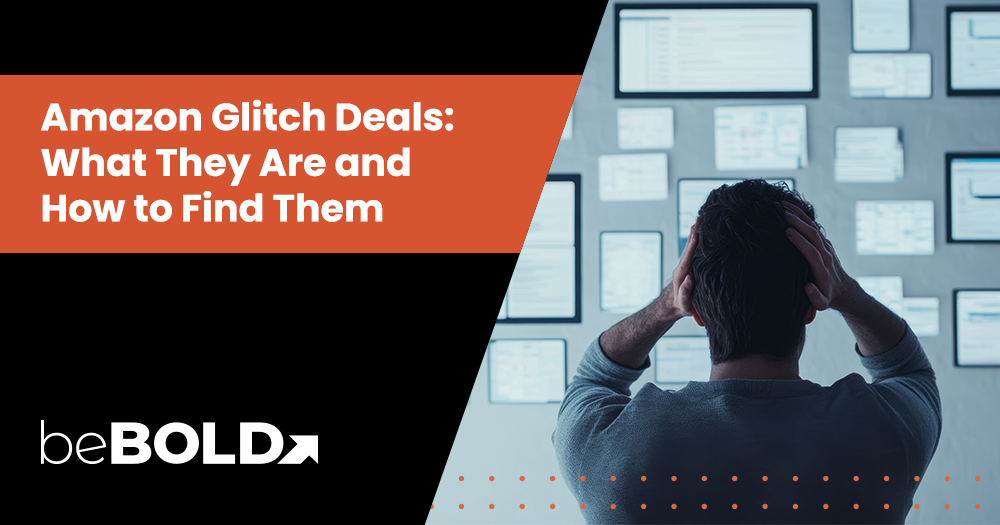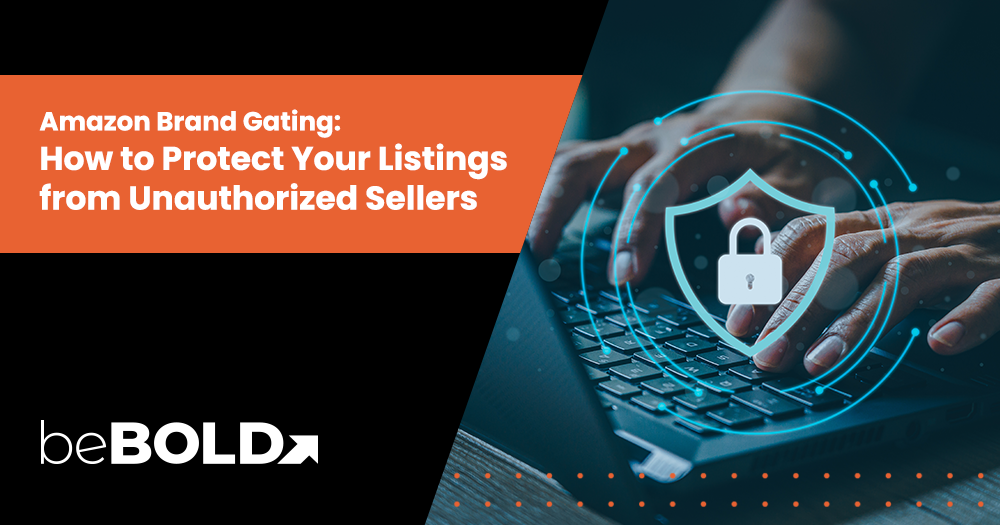Key Highlights
- Amazon glitch deals are accidental deep discounts caused by tech bugs, coupon errors, or sync issues.
- Common glitch types: $0.01 items, free products, mispriced bundles, and faulty promo stacking.
- Sellers face risks such as damaged listings, poor customer experiences, and negative metrics if they cancel glitch-affected orders.
- Glitches usually strike during Prime Day, Black Friday, or Amazon system updates.
- Watch glitch deals using tools like Keepa or threads on Reddit and Facebook.
- beBOLD Digital helps sellers avoid these traps with smart systems and margin-safe strategies
Ever spotted a $1,000 diamond ring listed for $9.99? That’s an Amazon glitch, a rare pricing error in Amazon’s system that savvy shoppers scramble to exploit. From a free laptop to a mispriced TV, these glitch deals Amazon accidentally publishes can cause a ripple effect across search results, product rankings, and even seller profit margins. While they may look like lucky finds, these deals often stem from system bugs, coupon stacking errors, or third-party software mishaps. The best part? You don’t need insider access to spot one. In this blog, we’ll break down how to do the Amazon glitch, why it happens, and how sellers can protect their bottom line.
What Is the Amazon Glitch Deal?
An Amazon glitch deal is exactly what it sounds like: a fluke in the pricing system that results in unusually low prices. But don’t confuse it with regular discounts. These deals are unintentional and often triggered by behind-the-scenes issues like:
- Human Error: Sellers or Amazon employees may accidentally input incorrect prices.
- Software Bugs: Updates or issues in Amazon's system can lead to pricing errors.
- Coupon Stacking: Misconfigured promotions can cause discounts to apply incorrectly.
- Third-Party Seller Sync Issues: Errors in synchronization between inventory and pricing systems.
These types of glitches can affect anything, from a budget gadget to a luxury diamond ring, and once live, they’re visible in search results like any normal product.
However, since they go against the retail price, they’re usually fixed fast. Think of it as a race: spot the deal, check out quickly, and hope your Amazon account processes it before it’s pulled.
Want to strengthen your foundation before diving into advanced strategies? Master how to sell items on Amazon with our ultimate guide.
What Are the Types of Amazon Glitches the World has Experienced?

Over the years, users have witnessed several strange but profitable Amazon glitch deals. Here are the most common types:
1. Percentage‑off Glitches
Extreme markdowns often show a product at a massive discount, like a 96% slash on a diamond ring, selling a $1,166 item for just $42.66
2. Free‑item Glitches
Occasionally, products like Amazon Echo are listed for free due to misconfigured discounts, though Amazon typically later cancels such orders.
3. 1‑Penny Price Glitches
In one major 2014 glitch, items were listed for £0.01 due to a third-party repricing tool error, resulting in thousands of unintended sales.
4. Third‑Party Software Glitches
Faulty repricers or inventory sync tools can push prices far below the intended retail price, until Amazon’s price guard steps in.
5. Bundle Glitches
Bundled listings with mismatched pricing can accidentally offer multiple high-value products for the price of one.
6. Coupon/Promo Code Errors
Stacking multiple promo codes or misconfigured discounts can create unintended ultra-low prices, even turning high-ticket items into glitch deals.
These glitch types highlight how technical hiccups from bugged coupons to rogue software can result in surprisingly steep bargains (or headaches!).
How Does the Amazon Glitch Impact Sellers?

While Amazon glitch deals may feel like a win for bargain hunters, they can be a nightmare for sellers. When prices drop due to a glitch in Amazon’s system or a third-party tool error, sellers often face serious consequences, financial and operational.
Here’s how pricing glitches can impact Amazon sellers:
- Massive Losses on Profit Margins: A product worth $500 selling for $5 can wipe out profit, and even cost the seller money when fees and shipping are factored in.
- Inventory Depletion: Glitches often result in bulk purchases. Sellers can see their entire inventory vanish in minutes, leaving them out of stock for legitimate buyers.
- Negative Account Health: Canceling glitch orders can trigger order defect rates, late shipment metrics, or policy violations, hurting Amazon account health and seller rankings.
- Listing and Keyword Disruption: A pricing error can mess with a product’s search results, bullet points, rankings, and even its main image if the product listing gets flagged or edited.
- Customer Service Overload: Glitches create confusion, refund demands, and angry buyers, especially when orders get canceled.
- Reputation Damage: Too many pricing issues can erode customer trust, especially for private label or smaller third-party sellers.
Wondering how much it costs to sell on Amazon? Click here for a full breakdown.
Don’t leave your listings vulnerable. Partner with beBOLD Digital to build a glitch-proof pricing strategy, protect your profits, and keep your account health in check. Let our team manage the tech while you scale your brand with confidence.
How to Protect Your Products from Potential Amazon Price Glitches?

Preventing an Amazon pricing glitch isn’t just about tech; it’s about vigilance, automation, and good seller practices. Here’s how to minimize the risk:
1. Use Repricing Tools with Price Floors
Automated repricers help stay competitive, but they can also misfire. Always set a minimum price threshold to ensure your products never drop below your cost or desired profit margin, even during algorithm updates or competitive shifts.
Here’s how to stay protected from the Amazon price glitch:
- Choose tools with “price floor” settings.
- Monitor for sudden price fluctuations.
- Regularly update thresholds based on costs.
2. Sync Inventory & Pricing Systems Properly
Third-party seller sync issues are a leading cause of glitch deals. Ensure that your Amazon inventory and pricing tools are correctly integrated to avoid mismatches or outdated data.
Take these steps to stay aligned:
- Use trusted software, like JungleScout and InventoryLab, with real-time sync.
- Audit system connections regularly.
- Avoid scheduling updates during peak shopping hours.
3. Set Up Alerts for Unusual Price Activity
Catching errors early can prevent losses. Many seller tools allow alerts for suspicious pricing activity so you can act before it's too late.
Stay proactive with alerts by:
- Enabling price drop notifications.
- Using keyword or product-specific monitoring.
- Assign someone to act on alerts quickly.
4. Test Listings Before Going Live
Even small errors in pricing or bundling logic can cause major glitches. Always test listings before publishing, especially when applying coupon stacking or running promotions.
Before going live, remember to:
- Preview the listing and main image.
- Test all promo codes and coupon rules.
- Simulate a customer’s checkout journey.
Want a step-by-step guide to listing products correctly? Check out our Amazon product listing blog to avoid common setup errors that lead to pricing issues.
When Is the Next Amazon Glitch?

Amazon glitch deals are unpredictable by nature, but they’re not completely random. While you can’t mark your calendar for the next pricing error, certain patterns and triggers make glitches more likely to occur. Staying aware of these can give you an edge.
Here’s when Amazon glitches are most likely to happen:
- Major Sales Events: High-traffic days, like Prime Day, Black Friday, or Cyber Monday, put pressure on Amazon’s system. With so many listings, flash sales, and sellers updating prices, errors can (and do) slip through.
- After System Updates: When Amazon rolls out backend updates to its algorithm or seller dashboards, there’s a brief window where bugs or sync issues can trigger accidental price drops.
- During Promotional Periods: Misconfigured coupon stacking, promos, or third-party integrations often lead to glitches, especially when sellers run multiple deals at once.
To improve your chances of catching a glitch in real time:
- Join active Facebook groups or Reddit threads that track glitch deals.
- Use price tracking tools like CamelCamelCamel or Keepa.
- Monitor unusual search results during peak hours.
While there’s no exact formula, staying alert gives you a strong advantage.
Protect Your Brand with beBOLD Digital’s Expert Amazon Solutions
Amazon glitch deals might thrill buyers, but for sellers, they can be a costly wake-up call. From disrupted listings to damaged reputations, one pricing error can create a ripple effect across your entire catalog. That’s where proactive strategy and expert oversight make all the difference.
At beBOLD Digital, we help Amazon sellers navigate the chaos of pricing, promotions, and algorithm updates with confidence. Our team builds custom strategies that protect your profit margins, optimize your listings, and prevent costly errors before they happen. Whether you're scaling a private label brand or managing multiple SKUs, we bring the expertise, automation, and data-backed insights you need to stay in control.
You’ve worked hard to grow your brand; don’t let a glitch undo it. Partner with beBOLD Digital to build a smarter, safer Amazon business that scales without surprises.
Frequently Asked Questions
Are Amazon glitch deals legal?
Yes, it's legal to purchase items listed at incorrect prices due to glitches. However, Amazon reserves the right to cancel such orders if they deem the price a mistake or system error.
How can I increase my chances of finding glitch deals?
Regularly monitor deal websites, join online communities, use price tracking tools, and set up alerts for specific products.
What should I do if I find a glitch deal?
Act fast. Add the item to your cart and check out immediately. Take screenshots of the product page and order confirmation in case the order is later canceled or disputed by Amazon.
Can I rely solely on glitch deals for savings?
No, glitch deals are rare and unpredictable. While they can offer huge savings, they’re best used as bonus opportunities, not your primary strategy for shopping or budgeting.
What should I do if my product is affected by a pricing glitch?
First, pause the listing to prevent further sales. Then, contact Amazon Seller Support to explain the error. Avoid mass cancellations if possible, as they can hurt your account health. Use repricing safeguards to prevent future glitches.
Ready to take control of your listings? Visit beBOLD Digital and schedule your free strategy call today!











Comments